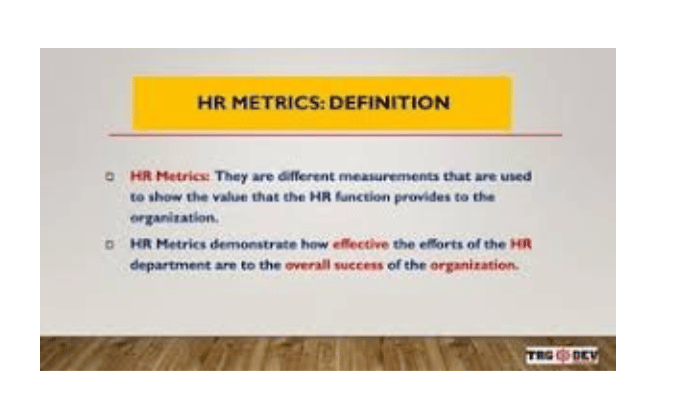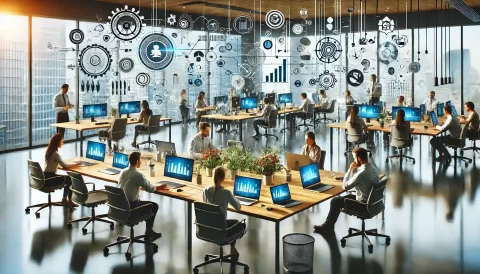Imagine having a crystal ball that reveals the inner workings of your workforce, providing insights into their strengths, challenges, and impact on your business success. That’s the power of HR metrics!
According to a recent survey by 69% of organizations believe workforce analytics is critical to their success. But where do you begin? This comprehensive guide will equip you with the knowledge and tools to navigate the world of HR metrics and unlock their transformative potential.
As Albert Einstein said, “Not everything that counts can be counted, and not everything that can be counted counts.” While HR metrics provide invaluable data, remember, they are just one piece of the puzzle. Use them in conjunction with your professional judgment to create a thriving work environment.
Introduction To HR Metrics:

HR metrics are measurable data points that provide objective insights into various aspects of your human resources function. These metrics track a wide range of activities, from recruitment and retention to employee engagement and development. By analyzing this data, you gain a deeper understanding of your workforce’s strengths, weaknesses, and opportunities.
In today’s dynamic business landscape, data-driven decision-making is no longer a luxury, but a necessity. Intuition and guesswork can only take you so far. HR metrics empower you to move beyond these limitations by providing objective and quantifiable data to guide your HR strategies. This data-driven approach ensures your decisions are well-informed, strategic, and aligned with your overall business goals.
HR metrics allow you to track and monitor various HR and recruitment activities. This includes measuring the time to hire, cost per hire, turnover rate, and employee engagement. By tracking these metrics over time, you can identify trends and patterns, helping you understand what’s working well and where there’s room for improvement.
HR metrics aren’t just valuable for the HR department; they can also provide valuable insights into other areas of your business. For example, by analyzing employee engagement metrics, you can gain insights into customer satisfaction and productivity. Similarly, tracking retention rates can help you understand the financial impact of employee turnover.
Why HR Metrics Matter- Driving Strategic Decision-Making:
Imagine navigating your business blindfolded. HR metrics act as your guiding light, shedding clear and valuable insights on your workforce. These insights empower you to make strategic decisions that:
Optimize talent management: By tracking metrics like turnover rate and time to hire, you can identify areas to improve your recruitment and retention strategies, ensuring you have the right talent in place to achieve your business goals.
Boost employee engagement: Measuring employee engagement through surveys or other methods allows you to understand how connected and invested your employees feel in their work. High levels of engagement are linked to increased productivity, improved customer satisfaction, and lower turnover rates.
Support strategic planning: HR metrics provide valuable data that can inform your strategic planning process. For instance, analyzing workforce demographics and skill gaps can help you anticipate future talent needs and develop proactive strategies to address them.
Highlight HR’s impact on business goals: By effectively communicating HR metrics and their impact on key business outcomes, you can demonstrate the strategic value of the HR function within your organization.
Transforming HR through Agile Workforce Solutions
Utilizing HR Metrics Effectively- A Roadmap To Data-Driven HR Decisions:

Before diving into specific metrics, it’s crucial to approach HR data analysis strategically. Here’s a roadmap to guide you:
Start with a Hypothesis or Question: Clearly define what you want to learn from the data. What specific aspect of your HR practices are you interested in evaluating? Having a clear question in mind will guide your analysis and ensure you’re collecting relevant data.
Turn to HR Technology for Data Analysis: Manual data analysis can be time-consuming and error-prone. Fortunately, many HR software solutions and HRIS (Human Resource Information System) offer built-in data analysis tools and functionalities. These tools can help you collect, visualize, and analyze HR data efficiently. Consider exploring solutions available on the hrtech marketplace, which brings together a wide range of HR technology providers under one roof.
Examples of Questions to Frame Your Analysis: Here are some examples of questions HR professionals can ask using HR metrics:
What is the impact of our training programs on employee performance?
Is there a correlation between employee engagement and retention?
Are we attracting and hiring the right talent for our open positions?
Collaboration between HR and Finance: A holistic understanding of the impact of HR initiatives often requires collaboration between different departments.
Working closely with your finance team can provide valuable insights into the financial implications of HR decisions. This collaboration ensures your HR strategies align with your organization’s overall financial goals.
Core HR Metrics To Monitor:
Now that you have a better understanding of how to approach HR data analysis, let’s explore some core HR metrics that every HR professional should track:
Turnover and Retention Rates: These metrics measure the rate at which employees leave the organization (turnover) and the rate at which you retain your workforce (retention), respectively. Understanding these rates is crucial for assessing the effectiveness of your recruitment and retention strategies.
Cost Per Hire: This metric reflects the total cost associated with filling an open position, including advertising, recruiting fees, and onboarding expenses. Tracking cost per hire helps you identify areas where cost savings might be possible in your recruitment process.
Time to Hire and Time to Fill: These metrics measure the average time it takes to fill an open position from the moment the position is posted to when it’s filled. A longer time to hire can indicate inefficiencies in your recruitment process and impact your ability to attract top talent.
Diversity, Equity, Inclusion, and Accessibility (DEI&A): Tracking various DEI&A metrics, such as representation rates across different demographics and pay equity analysis, helps you assess your progress towards creating a diverse, equitable, and inclusive workplace.
Total Cost of the Workforce (TCOW): This metric encompasses all the direct and indirect costs associated with your workforce, including salaries, benefits, payroll taxes, and training expenses. Understanding TCOW allows you to assess the overall financial impact of your workforce and identify areas for potential cost optimization.
Compensation and Pay Equity: Implementing metrics like salary range ratios and pay gap analysis helps ensure you’re offering competitive pay and addressing any potential pay inequities within your organization.
Employee Engagement: Measuring employee engagement through surveys or other methods helps you understand how connected and invested your employees feel in their work. High levels of employee engagement are often linked to increased productivity, improved customer satisfaction, and lower turnover rates.
Talent Acquisition: Tracking costs associated with bad hires and measuring the success of your recruitment process through metrics like source of hire and offer acceptance rate helps you identify areas for improvement in your talent acquisition strategies.
Learning and Development: Tracking employee participation in training programs and measuring the impact of training on employee performance helps you ensure your learning and development programs are effective in equipping your workforce with the necessary skills and knowledge.
Workforce planning: By analyzing skills gaps and future talent needs using workforce planning metrics, you can proactively develop strategies to address future talent shortages and ensure you have the right skills available to meet your business goals.
Advanced HR Metrics for Deeper Insights:
While core HR metrics provide a solid foundation, venturing into advanced metrics can offer even deeper insights into your workforce. Here are a few examples:
Productivity: Measuring individual and team productivity can help identify areas for improvement and optimize workflows. Common metrics include revenue generated per employee and number of units produced per hour.
Manager Effectiveness: Effective managers are crucial for employee engagement and retention. Metrics like employee Net Promoter Score (eNPS), 360-degree feedback results, and retention rates within specific teams can help assess manager effectiveness.
Employee Net Promoter Score (eNPS): This metric gauges employee loyalty and willingness to recommend your company as a workplace to others. It’s calculated based on employee responses to the question: “On a scale of 0 to 10, how likely are you to recommend this company as a workplace to a friend or colleague?”
Career Path Ratio and Salary Change: Tracking these metrics helps you understand employee career growth opportunities within your organization. Analyzing trends over time can reveal if employees are being adequately challenged and compensated for their growth.
Key Areas Where HR Metrics Shine:
HR metrics play a vital role in several key areas:
Recruitment: Metrics like time-to-fill and cost-per-hire help you streamline your recruitment process and attract top talent efficiently.
Diversity, Equity, Inclusion, and Belonging (DEI&B): Tracking DEI&B metrics like representation rates and pay equity analysis enables you to build a more diverse and inclusive workplace, fostering a sense of belonging for all employees.
Retention: Metrics like turnover rate and reasons for leaving help you identify factors contributing to employee turnover and develop strategies to improve retention.
Leveraging Technology for HR Metrics Success:
Manual data collection and analysis can be cumbersome and error-prone. Fortunately, technology offers powerful tools to empower you in your HR metrics journey:
HRIS (Human Resource Information System): An HRIS acts as a central repository for all your HR data, streamlining data collection and analysis compared to manual methods.
HR Analytics Tools: Many HR software solutions offer built-in analytics tools that provide visualizations, dashboards, and reporting functionalities, enabling you to easily gain insights from your data.
User Experience (UX) and Feature Availability: When choosing HR software, prioritize solutions with a user-friendly interface and features that cater to your specific data analysis needs.
Strategic Applications of HR Metrics
HR metrics go beyond simply measuring the past; they can be used to predict the future and shape your HR strategy proactively. Here are some strategic applications:
Predicting future business needs: By analyzing trends in HR data, such as employee demographics and skill sets, you can anticipate future talent needs and adjust your recruitment and development strategies accordingly.
Utilizing an HR Metrics Dashboard: A comprehensive HR metrics dashboard provides a centralized view of key metrics, allowing you to monitor trends, identify areas for improvement, and track progress towards your HR goals.
Promoting modern workforce solutions featuring HR dashboards: Implementing HR solutions with built-in HR dashboards empowers your leadership team to make data-driven decisions across the organization, fostering a culture of data-driven decision-making.
All set to turn your HR function into a data-driven powerhouse? Keep these final nuggets of wisdom in mind as you embark on your journey. HR Tech not only provides the platform for discovering these solutions but ensures that you’re selecting from the best in the market, primed to elevate your data-driven decision-making.
Conclusion:
While the abundance of available HR metrics might seem overwhelming, remember: quality over quantity reigns supreme. Here’s why selecting relevant metrics is crucial:
Focus on alignment with your goals: Don’t get caught up in tracking every metric imaginable. Instead, prioritize metrics that directly align with your specific HR goals and objectives.
Actionable insights: Choose metrics that provide clear and actionable insights. These insights should enable you to make informed decisions and take concrete steps to improve your HR practices.
Avoid information overload: Tracking too many metrics can lead to information overload, making it difficult to identify and interpret key trends.
By carefully selecting relevant HR metrics and using them strategically, you can unlock their true potential and transform your HR function into a data-driven powerhouse, ultimately propelling your organization towards success.
Explore the hrtech marketplace to discover a world of HR solutions designed to streamline your data collection, analysis, and decision-making processes.
Let’s build a brighter future for your workforce, together!





